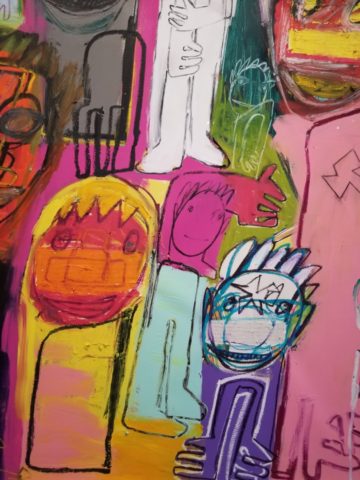
Originally published in The Marina Times San Francisco in August 2019
Richard Prince’s “High Times” paintings will be on exhibit at the Gagosian through August 23rd. These whimsical, color-saturated character studies are the end result of years of figurative explorations and interest in marijuana culture.
Bic pen drawings of “dead” heads came first (not related to the band the Grateful Dead). In 1972 and 1973, Prince created many “Dead Head” drawings and brought 20 of them to New York City when he moved there in 1974. “They were probably the first things I did that ever had any soul.” After starting a new life in New York City, he was attracted to anything that didn’t remind him of Richard Prince.
Starting in the late 70’s, Prince made a name for himself with “rephotographs”. Appropriating cigarette advertisements and found photography in already published magazines and newspapers, he took photos of photos as a new form of pop art where the artist’s hand is removed, and all that remains is the artist’s eye as a kind of new vantage point of culture.
Richard Prince quickly became a part of the pop culture he was appropriating. Images of nurses, cowboys, and fashion collaborations with designers like Marc Jacob and Louis Vuitton took his art in directions that eventually lead back to his beginnings. After moving out of New York City in 1998, Prince became a father and the straightforward, sincere nature of his child’s drawings hearkened back to the Heads from the early 1970’s. He still wasn’t ready to “…use his own blood”, as he put it, and fully return to that level of authenticity. The distance was created by asking a question – what would a hippie draw? The question reappeared after Prince viewed a catalog of Willem de Kooning drawings. Inspiration arrived in the form of tearing into the catalogue in a “hippified” alteration. Since the drawings reminded him of his own, he used his hippie/heads pose with a de Kooning style in a mash-up. The catalog was something brand new: heads, arms and legs were added and heavily altered; he drew the word “HIPPIE” on the cover and collaged body parts onto de Kooning’s women. Some he even turned into men. This new de Kooning/Prince hybrid outside of gender was all inclusive. Prince decided to return it to the MOCA who considered buying it, but did not. “Hippie de Kooning” was put away and forgotten until Prince got a call from High Times magazine requesting cover art for an upcoming issue. Somehow they knew about the hippie book. Five different Hippie Drawings became five different covers for the special issue.
The story continues with Q-Tip from A Tribe Called Quest. He’d also, somehow, heard of the Hippie Drawings and requested one from Prince for the Tribe’s new album cover. Once “We Got it from Here…Thank You 4 Your Service” came out, the artist started listening to the album on repeat. Working with High Times and the Tribe sent the Hippie Drawings into its next evolution. The Super Group series started when Prince began making art from album sleeves. Then, in 2016, Prince made a painting of four figures that he called his own Super Group. Based on his earlier Hippie Drawings, the four figures seemed like a fictitious band. He began writing names of bands on sleeves and drawing and painting his hippie figures.
Inkjet reproductions were introduced in 2017. Almost any surface –paper, canvas or linen- can be collaged with inkjet, the images rephotographed, reproduced, and altered. The artist started to make inkjet reproductions of his 1998-99 Hippie Drawings. Untitled, 2019 is an example of the appropriation of inkjet reproductions of the Hippie characters into the “High Times” exhibit. Oil stick, acrylic and charcoal are combined with the collaged inkjet images to create a densely layered field of color comprised of twisting bodies and smiling faces in the foreground. The layered canvas effect brings to mind the influence of de Kooning and his thick brushstrokes and vibrant, sometimes strange, figures. The theme continues throughout the gallery with large scale exuberant figures all created with this approach. A little pop culture nod to his past is included in repurposed photography from Bob Dylan’s album Blonde on Blonde, but added is a bottle of “Heaven’s Door” whiskey, a humorous reference to Dylan’s “Knocking on Heaven’s Door.”
Emotion and fun reappeared in his approach to making art. Prince said, “Yeah, I was cool with that. It was time. It was time to go back, remind…circle back to the ‘dead’ heads and do something that I was born to do.” High Times is the real thing, Richard Prince coming back to himself.